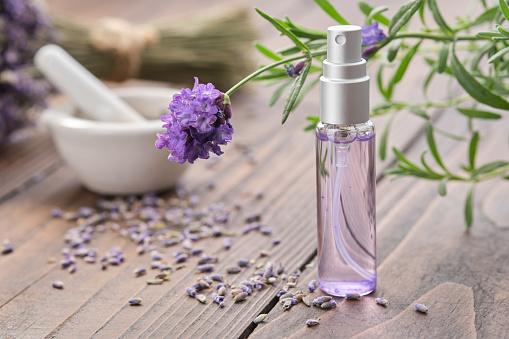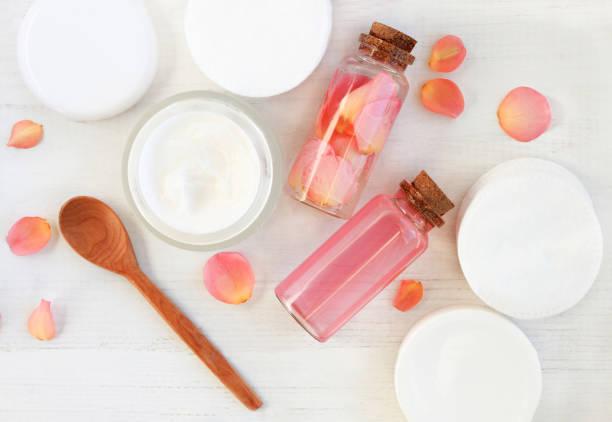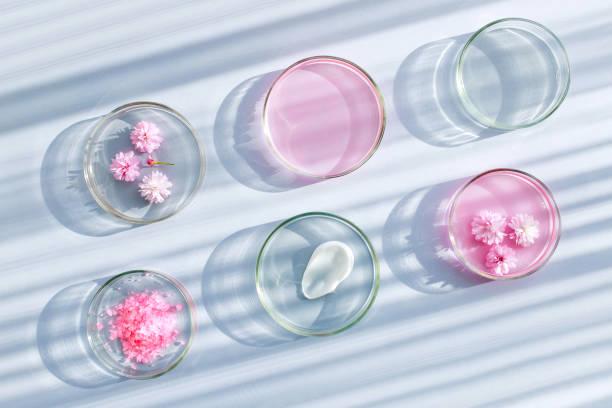A hydrolat, sometimes called "aromatic water" or "water of distillation", is a co-product of the essential oil resulting from the hydrodistillation of a plant. This means that the essential oil et hydrolat are produced jointly, even if the initial goal is the manufacture of the first of the two liquids.
Indeed, the first distillers of aromatic or medicinal plants quickly realized that the water that had been used to drive the molecules, and recovered at the end of the process, had also taken on the smell of the plant, even if it was more discreet.
They concluded that this water also had an interest.
Moreover, produced in great quantity, floral waters (hydrolats from flowers) became at this period more sought after than the essences too weak in yield. Then, progress in hydrodistillation techniques reversed the trend.
But if today the essential oil is the star in aromatherapy, some hydrolats have properties that deserve to be considered, especially since they are suitable for a large number of people. In the trade, we also sometimes meet the term of floral water, normally reserved for the products resulting from the distillation of flowers.

How is a hydrolat made?
As for essential oils, the definition of hydrolat is regulated by the French pharmacopoeia. It is "distilled vegetable water obtained by steam distillation of various plants, aromatic or not. They are constituted by the recondensed aqueous phase and separated from the essential oil when there is some ".
If the definition of essential oil admits several manufacturing processes, Hydrolats are the result of distillation (hydrodistillation or steam distillation). These two processes are based on exactly the same principle: water brought to the boil forms a vapor that draws the volatile molecules of a plant out of it before being cooled to return to a liquid state (condensation). This water is then separated from the essential oil which is hydrophobic (does not mix with water).
But compounds are never perfectly immiscible and remain in water a tiny fraction of the molecules of the essential oil. It is the hydrolat.
De quoi est composé l'hydrolat ?
As its name indicates, an aromatic water (hydrolat) is mainly composed of water. But it contains a small percentage of volatile molecules present in the essential oil, which could not be recovered at the time of the separation of the two phases. This remainder is infinitesimal, because it does not exceed in general the 0,2 % of the volume. The water having preserved mainly the most soluble molecules, its composition does not necessarily resemble that of the essential oil.
For example, the essential oil of petit grain bigarade is essentially made up of linalyl acetate (up to 60%) and yet this molecule is almost absent from orange flower water which contains mainly linalool, half as present in the essence. Conversely, Damask rose essential oil and its hydrosol are quite similar if we compare the molecules they contain.

How to use the hydrolat ?
Les eaux de distillation étant peu concentrées, on ne peut pas s’attendre à la même puissance que l’huile essentielle. On ne peut donc pas forcément choisir un hydrolat en fonction des bienfaits reconnus de l’huile essentielle à laquelle il est associé.
Cependant, chaque hydrolat présente des propriétés bien spécifiques qui lui permettent de soulager un certain nombre de maux. Comme ses cousines huiles essentielles, il s’utilise par voie orale et cutanée. La diffusion ou l’inhalation sont également possibles mais ont souvent moins d’intérêt. Aussi, les hydrolats se dilueront parfaitement dans un bain et seront un atout pour la formulation de produits cosmétiques.
En effet, les eaux aromatiques remplacent avantageusement l’eau pure dans la formulation d’une crème cosmétique, car celles-ci lui apportent des propriétés et de la stabilité. Sinon, on retrouve les eaux aromatiques conditionnées dans des flacons pulvérisateurs, afin de pouvoir aisément les répartir sur la peau, dans l’air ou sur des tissus.
How to choose your hydrolat ?
Comme pour les huiles essentielles, il est possible de choisir une eau aromatique en fonction de ses indications thérapeutiques ou de son arôme si le but est de l’utiliser en cuisine. Cependant, il est préférable de s’assurer de sa bonne qualité pour observer les effets escomptés à l’utilisation.
En plus de toujours bien identifier le nom latin de la plante distillée afin d’éviter une confusion malheureuse, l’étiquette doit être lue consciencieusement. Bien sûr, des produits bio et 100 % purs sont à privilégier. Les hydrolats rencontrant des problèmes de stabilité, certains produits contiennent des conservateurs permettant de les garder plus longtemps, mais qui en altèrent la pureté et vont limiter l’utilisation par voie orale. Pour assurer une bonne tenue sans ajout d’additif, le flacon doit être opacifié (souvent de couleur bleue) et correctement scellé.
Aussi, pour s’assurer un liquide avec une concentration suffisante, privilégiez le ratio 1:1 qui signifie que la distillation d’un kg de plante produit un kg d’hydrolat. Tout autre ratio conduit à une eau de distillation extrêmement diluée, qui risque donc d’être peu efficace. Enfin, fiez-vous à la dénomination du produit qui ne peut s’appeler différemment qu’hydrolat ou eau florale. Toute autre dénomination même proche (hydrosol par exemple) ne réfère pas à une eau obtenue après distillation d’une plante et ne suit donc pas les mêmes règles d’utilisation.
Les précautions à prendre avant utilisation de l'hydrolat
The advantage over essential oils is that hydrosols are generally suitable for everyone. However, it is important to always follow the recommendations, because aromatic waters sometimes also contain powerful molecules and are also a source of allergy.
For pregnant women, breastfeeding women and babies under 3 months old, the recommendations should be carefully followed, even if most hydrosols can be used by everyone. In this context, some hydrolats allow you to benefit from certain applications of the essential oil with less or no inconvenience. The most striking example is perhaps that of peppermint hydrosol, which is refreshing and will ease difficult digestion as early as three years old, whereas with essential oils, you have to wait until adolescence.
Comment bien conserver les hydrolats ?
Essential oils are so concentrated and devoid of water that they are not a favorite playground for bacteria and other microorganisms.
The story is a little different for waters of distillation. Even though they contain molecules that are generally antiseptic, the presence of water in large quantities makes them vulnerable to degradation. In the absence of preservatives, a hydrolat can be kept for 6 months after opening, preferably in the refrigerator, dry and protected from light. Beyond that, bacteria or fungi are likely to have colonized the bottle. An unpleasant smell may result. At the same time, with time, the molecules present can also degrade.
Some recipes based on hydrolat
Since taking a hydrolat is less risky than taking an essential oil, it is often taken in larger quantities. Also, being water soluble, it is easier to administer. Here are two recipes to get you started with hydrolatherapy.
Digest well with peppermint hydrosol
During festive periods, heavy and rich meals follow one another and the stomach can no longer keep up. In this case, or for people suffering from slow digestion, dilute a teaspoon of peppermint hydrosol in a glass of water. To drink from 3 years old after the meal.
Eliminate eczema with rose water
Eczema is a real scourge for those who suffer from it. Tightness, itching, unsightly patches, this skin disease does not facilitate the life of those who are subject to it. Difficult to get rid of even with the help of a dermatologist, eczema often resists. To avoid long courses of medication and to reduce the condition, as early as 3 months, it is possible to take a teaspoon ofDama rose waters, diluted in a glass of water or bottle. Do this until the symptoms improve.

Hydrolats are very gentle alternatives to essential oils. Very interesting to treat certain disorders and accessible to practically everyone, they are generally less effective.
Nevertheless, they have the advantage of being much easier to use and entail fewer risks for the user. It is an ideal solution to improve certain symptoms in young children, when the use of an essence is impossible, or simply if you prefer gentle care.
It should also be noted that these distillation products are of real interest in cosmetics, replacing pure water.



